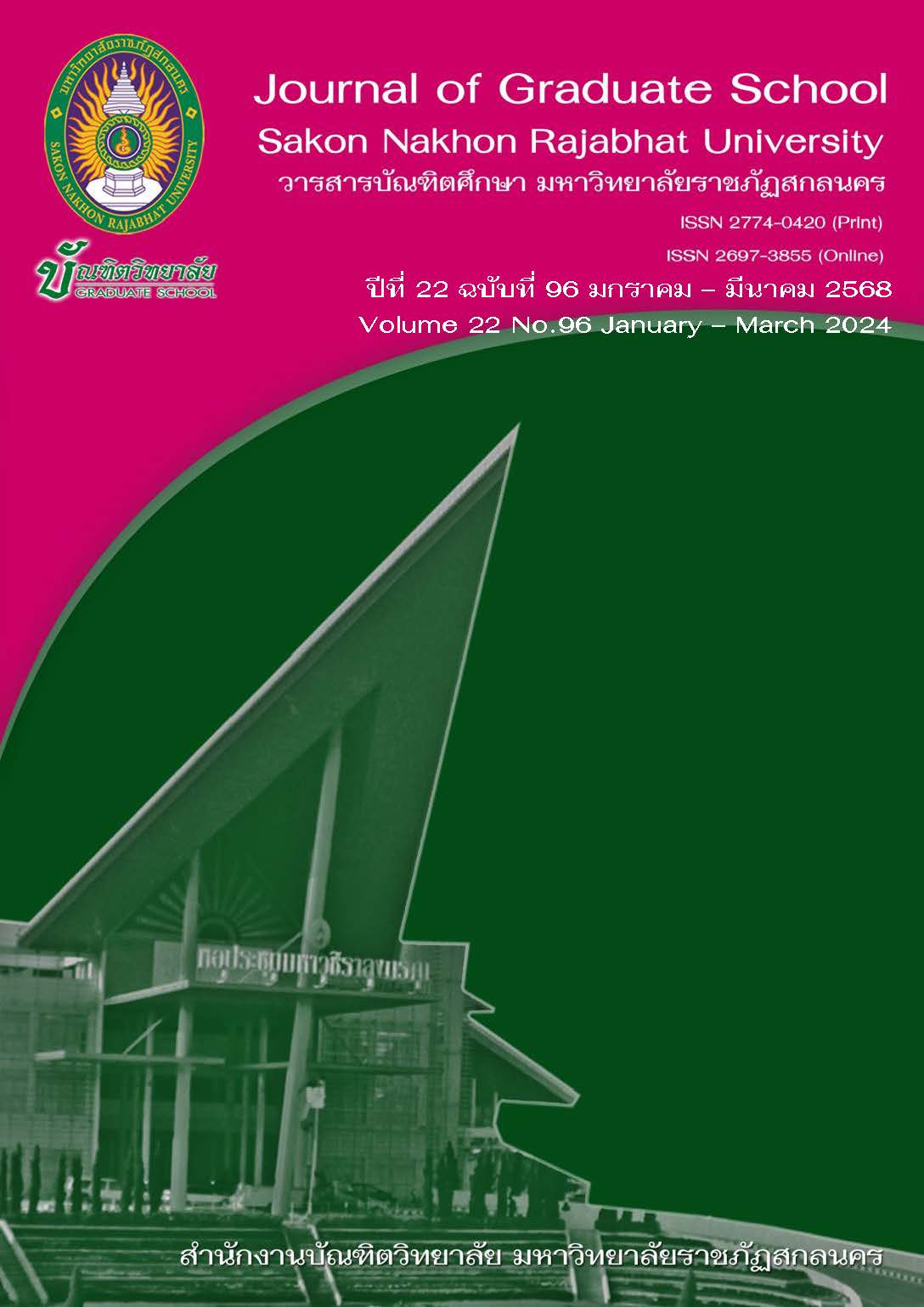GUIDELINES FOR DEVELOPING DIGITAL LITERACY OF TEACHERS IN SCHOOLS UNDER NAKHON PHANOM PRIMARY EDUCATIONAL SERVICE AREA OFFICE 1
Main Article Content
Abstract
The purposes of this research were 1) to examine the current and desirable conditions of teachers’ digital literacy, 2) to assess the needs for teachers’ digital literacy, 3) to establish guidelines for developing digital literacy of teachers in schools under Nakhon Phanom Primary Educational Service Area Office 1, and 4) to assess the appropriateness and feasibility of guidelines for developing digital literacy of teachers in schools under Nakhon Phanom Primary Educational Service Area Office 1. The sample group consisted of 351 teachers working in schools under Nakhon Phanom Primary Educational Service Area Office 1, obtained through multi–stage random sampling. The research instruments included a set of questionnaires, an interview form, and appropriateness and feasibility assessment forms. The statistics included percentage, means, standard deviation, and a Modified Priority Needs Index (PNIModified).
The research results revealed that
1. The current condition of teachers’ digital literacy was overall at a high level and the highest level in terms of the desirable condition.
2. The needs were ranked for the first three aspects comprising: 1) creating content, digital media, and presentation media, 2) possessing a critical judgment in consuming digital media, and 3) possessing basic knowledge in using electronic devices.
3. The guidelines for developing digital literacy of teachers in schools under Nakhon Phanom Primary Educational Service Area Office 1 consisted of six aspects as follows: 1) creating digital content, digital media, and presentation media, 2) understanding the digital environment, 3) possessing a critical judgment in consuming digital media, 4) possessing basic knowledge in using electronic devices, 5) accessing digital technology effectively, and 6) using digital technology with reliability and safety.
4. The evaluation of the guidelines for developing digital literacy of teachers in schools under Nakhon Phanom Primary Educational Service Area Office 1 revealed that the appropriateness and feasibility were at the highest level.
Article Details

This work is licensed under a Creative Commons Attribution-NonCommercial-NoDerivatives 4.0 International License.
บทความทุกบทความที่ตีพิมพ์ในวารสารบัณฑิตศึกษา มหาวิทยาลัยราชภัฏสกลนคร ถือว่าเป็นลิขสิทธิ์ของบัณฑิตวิทยาลัย มหาวิทยาลัยราชภัฏสกลนคร
References
กณิชชา ศิริศักดิ์. (2559). วิชาชีพครูเพื่อพัฒนาแนวทางการส่งเสริมสมรรถนะดิจิทัล. วิทยานิพนธ์ ค.ม. กรุงเทพฯ: จุฬาลงกรณ์มหาวิทยาลัย.
กัมพล เกศสาลี และกันยารัตน์ เควียเช่น. (2561). การรู้ดิจิทัลในการปฏิบัติงานของบุคลากรมหาวิทยาลัยราชภัฏเลย. วารสารมนุษยศาสตร์และสังคมศาสตร์ บัณฑิตวิทยาลัยมหาวิทยาลัยราชภัฏพิบูลสงคราม, 12(2), 503–514.
บุญชม ศรีสะอาด. (2560). การวิจัยเบื้องต้น ฉบับปรับปรุงใหม่. (พิมพ์ครั้งที่ 10). กรุงเทพฯ: สุวีริยาสาส์น.
วันเพ็ญ ผลิศร. (2561). ระบบคลาวด์เลิร์นนิงแบบอัจฉริยะเพื่อพัฒนาการรู้ดิจิทัล และทักษะการเรียนรู้แบบร่วมมือกัน. วารสารวิชาการพระจอมเกล้าพระนครเหนือ, 29(3), 518–526.
สถาบันพัฒนาคุณภาพวิชาการ. (2563). เข็มทิศทางการศึกษาไทยในศตวรรษที่ 21. กรุงเทพฯ: บริษัท พัฒนาคุณภาพวิชาการ (พว.).
สำนักงานพัฒนาวิทยาศาสตร์และเทคโนโลยีแห่งชาติ. (2560). ทักษะความสามารถสำหรับการรู้ดิจิทัล. เข้าถึงได้จาก https://www.nstda.or.th/. 17 มิถุนายน 2566.
สำนักงานคณะกรรมการข้าราชการพลเรือน (2561). ทักษะดิจิทัลของข้าราชการและบุคลากรภาครัฐเพื่อปรับเปลี่ยนเป็นรัฐบาลดิจิทัล. กรุงเทพฯ: เอกสารแนบหนังสือราชการสำนักงาน ก.พ. ที่ นร1013/ว6 ลงวันที่ 18 พฤษภาคม 2561.
สำนักงานเขตพื้นที่การศึกษาประถมศึกษานครพนม เขต 1. (2563). แผนปฏิบัติการประจำปีงบประมาณ พ.ศ. 2563. กลุ่มนโยบายและแผน. นครพนม: สำนักงานเขตพื้นที่การศึกษาประถมศึกษานครพนม เขต 1.
สำนักงานเลขาธิการสภาการศึกษา. (2562). รายงานการศึกษา เรื่อง แนวปฏิบัติของการสร้างและส่งเสริมการรู้ดิจิทัลสำหรับครู. กรุงเทพฯ: กระทรวงศึกษาธิการ.
สิริวัจนา แก้วผนึก. (2560). รูปแบบการพัฒนามรดกดิจิทัลด้วยกระบวนการเล่า เรื่อง ดิจิทัลแบบสืบสอบอย่างมีวิจารณญาณ บนเว็บ 3.0 เพื่อส่งเสริมการรู้ดิจิทัลของนิสิตนักศึกษา. วิทยานิพนธ์ ปร.ด. กรุงเทพฯ: จุฬาลงกรณ์มหาวิทยาลัย.
สุภารักษ์ จูตระกูล. (2560). ครอบครัวกับการรู้เท่าทันสื่อดิจิทัล (Digital Literacy) ของดิจิทัลเนทีฟ (Digital Natives). วารสารวิทยาการจัดการ มหาวิทยาลัยราชภัฎเชียงราย, 11(1), 99–118.
สุทธินันท์ ชื่นชม และคณะ. (2564). รูปแบบการพัฒนาทักษะการรู้ดิจิทัลของนักศึกษามหาวิทยาลัยราชภัฏเชียงใหม่เพื่อพัฒนาคุณภาพการเรียนรู้. วารสารสารสนเทศศาสตร์, 39(2), 16–33.
อุษา บานเย็น. (2560). การใช้เทคโนโลยีดิจิทัล เพื่อลดความเหลื่อมล้ำทางการศึกษาของเยาวชนใน 3 จังหวัดชายแดนภาคใต้. กรุงเทพฯ: วิทยาลัยการทัพบก.
Bawden, R. (2008). “Origins and concepts of digital literacy,” In C. Lankshear, & M. Knobe (Eds.), Digital literacies: Concepts, policies and practices. New York, NY: Peter Lang.
Digital Citizenship Institute. (2019). Common Framework for Digital Literacy, Skills and Readiness. Retrieved from https://www.dqinstitute.org/wp–content/uploads/2019/03/DQGlobalStandardsReport2019.pdf. July 6th, 2023.
Eshet, Y. (2002). Digital Literacy: A New Terminology Framework and Its Application to the Design of
Meaningful Technology–Based Learning Environments. Norfolk, VA: Association for the Advancement of Computing in Education.
Hoechsmann, M. and Helen DeWaard. (2015). Mapping Digital Literacy Policy and Practice in the Canadian Education Landscape. Ottawa: Media Smarts.
Poore. (2012). “การใช้สื่อสังคมในชั้นเรียน: คู่มือปฏิบัติที่เป็นเลิศ”: แปลโดย ฐิติ คําาหอมกุล. มหาวิทยาลัยศรีนครินทรวิโรฒ.
Summey, D. C. (2013). “Developing Digital Literacy,” A Framework for Professional Learning. London: Sage.
Tomczyk, L. (2019). Digital literacy skills as a key element of digital competence among teachers: A research perspective. The Routledge Handbook of Research Methods in the Study of Popular Music, London: Routledge.

